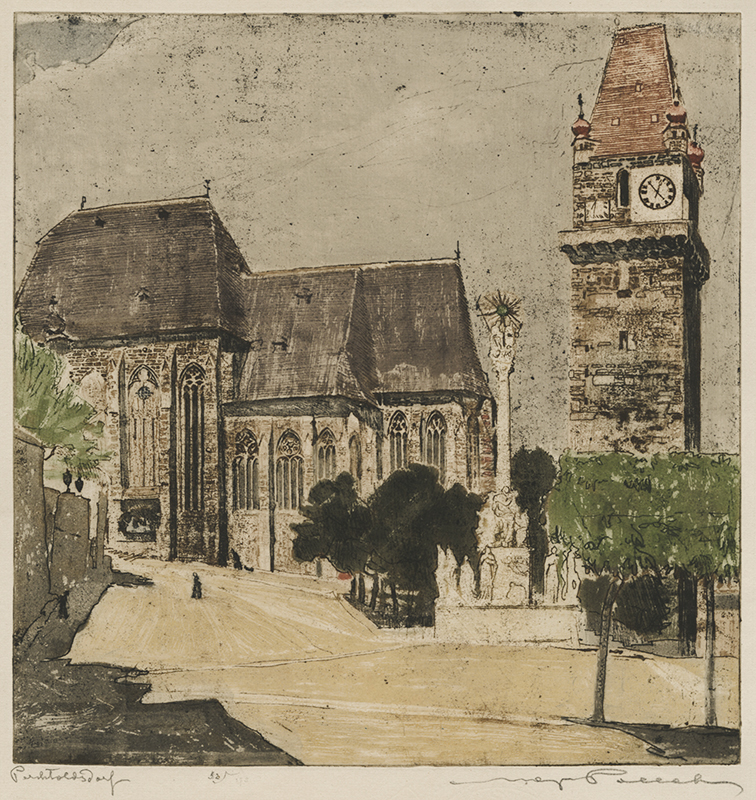Perchtoldsdorf is a drypoint and color aquatint created circa 1920 by Czech born artist Max Pollak. It is pencil signed, titled and annotated 52/. Perchtoldsdorf was printed chine collé with a support sheet of Van Gelder wove paper. It is annotated by the artist along the lower margin, Printer a. 50 and it bears the red collection stamp of Friedl Pollak. The platemark measures 12-3/4 x 12" platemark.
Perchtoldsdorf is a market town located next to the Vienna city limits in the Mödling District in Lower Austria. The town is noted for the Perchtoldsdorf Castle which is thought to have been laid out prior to 1000 AD as part of a chain of fortifications along the eastern rim of the Vienna Woods.
Pollak’s drypoint and color aquatint Perchtoldsdorf depicts the market square with St. Augustine Church, the fortified tower house, and the Holy Trinity Column, also known as the Plague Column. St. Augustine Church was originally the chapel of the Perchtoldsdorf castle but it was assigned as the parish church in 1217. The tower house (Wehrturm), with its height of 200 feet, is the town’s landmark and was built between 1450 and 1521 as part its defense. The plague was the source of pastor Maximilian Aunosky’s idea for a column in the market square but it wasn’t until after his death and the end of the Great Plague (1708-1714) that his successor realized the project. The foundation stone was laid in the fall of 1713 and the benediction took place in the summer of 1714. At the end of the nineteenth century the column was extensively restored and the balustrade was enlarged and some of the stone figures added.
Max Pollak, painter and printmaker, was born in Prague, Czechoslovakia in 1886. He was raised in Vienna and, in 1902, he entered the Vienna Academy of Art where he studied under William Unger and Ferdinand Schmutzer. In 1912, Pollak traveled to Italy, France, and Holland to study and paint. During the First World War, he was appointed painter of the Austrian Army.
He immigrated to the United States in 1927, living for a time on the east coast where he produced a series of color aquatints of New York, Cincinnati, and Detroit. His first exhibition was at the 57th Street Art Gallery in New York and he was commissioned by Theodore Dreiser in 1929 to illustrate his book, My City. In 1938, Pollak and his wife, Friedl, moved to San Francisco, California. Pollak was inspired by his new city and its environs and produced beautiful views of San Francisco Bay Area. Later travels included trips to Mexico and Guatemala.
Max Pollak was a member of the Chicago Society of Etchers and the California Society of Etchers. His work is represented in the collections of the Magnes Collection of Jewish Art and Life, Berkeley, California; the Jordan Schnitzer Museum of Art, University of Oregon, Eugene; the British Museum, London; the Metropolitan Museum of Art and the New York Public Library, New York; the Oakland Museum of California Art; the Fine Arts Museums of San Francisco, California; and the Smithsonian American Art Museum, Washington, D.C.



